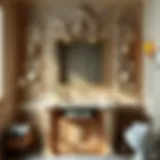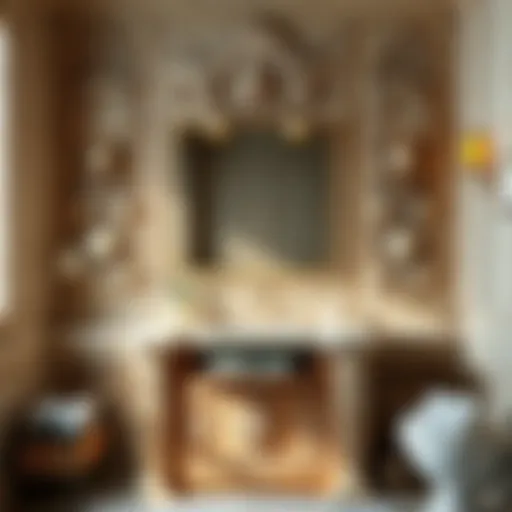Exploring One Bedroom Prefab Cabins: Design and Benefits
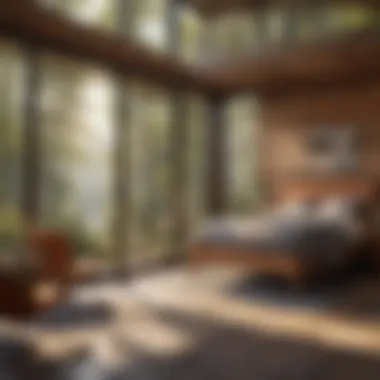

Intro
The conversation around one bedroom prefab cabins has gained considerable traction in recent years. Amid rising housing costs and the quest for sustainable living, these cabins are not just a trend; they're a viable alternative for many looking to harmonize their living space with their lifestyle. More often than not, these cabins serve as weekend getaways, primary residences, or additional guest spaces and showcase how modern design meets functionality. Understanding the appeal of prefab cabins involves looking at their flexibility in design, construction efficiency, and environmental considerations—all vital for today's discerning homeowners.
Trending Styles
Modern Minimalism
Modern minimalism represents a shift from the elaborate and often impractical designs of the past. The ethos behind this style revolves around the idea that less is more. In the context of one-bedroom prefab cabins, it means clean lines, ample natural light, and multifunctional spaces that do not compromise comfort.
- Focus on Functionality: Every element in a modern minimalist cabin serves a purpose, ensuring that no space is wasted. Furniture often serves dual roles, such as a bed that converts into a couch or a dining table that folds away.
- Natural Materials: Modern minimalist design frequently emphasizes the use of organic materials such as wood and stone. This not only enhances the aesthetic but also intertwines the cabin with its surrounding environment.
- Open Concept Living: The layout typically promotes an open floor plan. This not only maximizes space but also promotes a sense of community within the cabin.
Cozy Rustic
If modern minimalism appeals to some, others gravitate towards the warmth and charm of cozy rustic cabins. This style evokes nostalgia and comfort, drawing from traditional designs while integrating modern comforts.
- Rich Textures: Cozy rustic interiors often showcase wood beams, stone accents, and plush furnishings that invite relaxation. They create a feeling of homeliness that many yearn for in their living spaces.
- Nature-Inspired Decor: The use of colors and patterns that reflect the natural world—think earthy greens, browns, and soft creams—enhances the serene atmosphere of these cabins.
- Welcoming Outdoor Spaces: Porches and decks are often integral to cozy rustic cabins, providing attractive transitions between indoor comfort and the beauty of the outdoors.
Color Palettes
Calming Neutrals
Implementing a neutral color palette can do wonders for the illusion of space and serenity within a one bedroom prefab cabin. Soft whites, creams, and grays create an ambiance that feels vast and peaceful, making them ideal for small spaces.
- Light Reflection: Neutral colors can reflect natural light, helping to make a small area feel larger and more inviting.
- Versatility: Such palettes easily adapt to various decor styles. Homeowners can switch accents without a complete overhaul of color schemes.
Bold Accents
On the flip side, many owners might feel empowered to express their personality through bold accent colors. A vivid hue can be used thoughtfully to create focal points within the home.
- Feature Walls: Painting one wall in a bright, contrasting color can serve as a striking backdrop for furniture and artwork.
- Accessories and Textiles: Throw pillows and decorative items in vibrant colors can be an easy and cost-effective way to add flair without committing to a full renovation.
One-bedroom prefab cabins embody flexibility, offering home buyers the chance to enjoy eco-friendly, stylish solutions that cater to their unique lifestyles.
Understanding Prefab Cabins
Prefab cabins have become a beacon for those seeking an alternative to traditional housing. They represent a blend of modern construction techniques and the timeless charm of cabin living. Understanding prefab cabins is essential not just for potential homeowners, but also for anyone interested in the evolving landscape of sustainable architecture and efficient living spaces.
In this article, we will spotlight why one bedroom prefab cabins deserve attention, exploring their benefits from various angles. We aim to inform both housewives and homeowners about what these structures can offer, making the subject approachable while diving deep into significant details.
Definition and Overview
A prefab cabin, short for prefabricated cabin, is essentially a building whose various components are manufactured off-site and then transported to the final location for assembly. This method contrasts sharply with conventional building practices where homes are constructed entirely on-site, using materials that are typically sourced locally.
Prefab cabins often come in various styles, sizes, and designs, appealing to a wide array of tastes and preferences. For a one bedroom cabin, the possibilities are plentiful. From rustic timber-framed designs to sleek modern structures, the essence of a prefab cabin is its capacity for customization. Homeowners can select everything from layout to finishing materials, tailoring the cabin to reflect their individuality. Moreover, the immense flexibility can cater to different needs—whether it’s a cozy retreat in the woods or a minimalist living space for a single occupant.
Historical Context
The concept of prefabrication is not new. It dates back to the 19th century, particularly during the Industrial Revolution. At that time, iron and later steel allowed for quick, mass production of building materials. The popularity of log cabins in the early American frontier also laid the groundwork for the prefab ideology, where the need for rapid shelter echoed the core principles of today’s prefab cabins.
In the 20th century, cultural shifts and housing demand surged, prompting the rise of modern prefabricated homes. Today, advancements in technology and a growing awareness of sustainability are breathing new life into the prefab cabin movement. Homeowners are increasingly drawn to efficient living options that are not only cost-effective but also environmentally friendly. This trend represents a significant departure from the excess associated with traditional home building.
"Prefab cabins are transforming how we think about living spaces, marrying efficiency with personal expression."
Why Choose a One Bedroom Prefab Cabin?
When it comes to the modern housing landscape, the one bedroom prefab cabin stands out as a unique and practical option that appeals to a variety of lifestyles and preferences. The growing popularity of these cabins is not without reason; they offer a blend of flexibility, cost-effectiveness, and environmental consciousness that is hard to ignore. In this section, we’ll delve deep into the reasons why opting for a one bedroom prefab cabin may be the ideal choice for you.
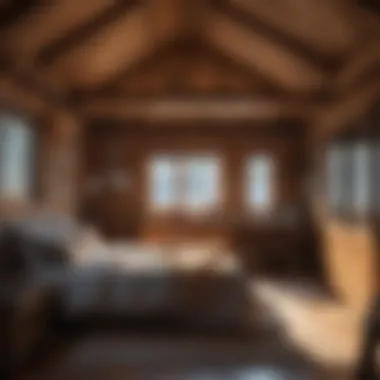

Space Efficiency
In today’s fast-paced world, maximizing space has become essential. A one bedroom prefab cabin embodies this principle beautifully. Whether you’re looking to simplify your life, downsize, or create a cozy getaway, these cabins often utilize clever design solutions that make the most of every square inch. With open floor plans and multifunctional furniture, you can easily transform a small space into a functional haven. Items like foldable tables and hideaway beds allow residents to adapt their living area according to their needs, making every nook and cranny count.
For instance, the open layout of a typical one bedroom cabin can create an airiness that larger spaces sometimes lack. You might even find your living space seems larger than it actually is, thanks to large windows that draw in natural light. This not only enhances your mental well-being but also cleverly blends indoor and outdoor living, allowing you to enjoy nature right from your home. The essence of space efficiency lies in making the tiny feel mighty.
Affordability Factors
Let’s talk about the dollars and cents. With the rising costs of traditional housing, prefab cabins present a more budget-friendly option. They often come at a significantly lower price point than conventional homes, cutting down on both purchase and ongoing maintenance expenses. The streamlined construction process associated with prefab homes typically results in reduced labor costs, which can directly affect the final bill you pay.
Additionally, considering long-term costs, many prefab cabins are designed to be energy-efficient. This can lead to major savings on utility bills. Those energy-efficient appliances and high-quality insulation not only make these homes easier on the environment but also on your wallet.
"A one bedroom prefab cabin can save you money upfront and in the years to come, allowing you to focus more on experiences rather than expenses."
Customization Options
One of the most compelling arguments for choosing a one bedroom prefab cabin is the extensive customization options available. Unlike traditional homes that might require hefty renovations to meet your style, prefab cabins are built with flexibility in mind. You can choose from a range of designs, layouts, and materials that suit your preferences and needs. Whether you imagine a rustic retreat or a sleek, modern space, there’s a prefab option to match.
You might even opt for eco-friendly materials like reclaimed wood or bamboo, which can make your home stand out while being kind to the planet. Furthermore, features such as deck space, storage solutions, and even outdoor living areas can be tailored to fit your lifestyle. When it comes to the kitchen and bathroom, homeowners can select finishes that reflect their taste—everything from countertops to flooring can be personalized.
Design Elements of One Bedroom Prefab Cabins
When considering a one bedroom prefab cabin, the design elements play a central role in determining both functionality and aesthetics. Each design decision not only reflects personal style but also impacts how space is utilized and how it feels to live in. Building a home that resonates with its inhabitants isn’t merely about wood and nails; it’s about crafting a space that matches lifestyle needs and desires. Thus, exploring the design elements is essential to understand how they enhance the living experience.
Layout Considerations
The layout is the backbone of any living space. In a one bedroom prefab cabin, maximized layout can yield a sense of openness even in confined areas. Clever arrangements can create an airy feeling which allows light to dance freely across the walls. Think about the line between comfort and functionality; it’s essential to align the design with how one intends to use the space.
A good rule of thumb is prioritizing common areas. The kitchen and living space often merge in smaller cabins to foster a communal atmosphere. Within this blend, consider using multifunctional furniture, like a pull-out sofa or extendable dining table, to ensure flexibility without compromising space.
- Pro Tip: Utilizing vertical space for storage can also prevent a cluttered floor area. Shelves, hooks, and cabinets build a practical environment without sacrificing visual aesthetics.
Interior Design Trends
Interior design trends for prefab cabins reflect a growing admiration for simplicity and nature. Many are moving away from overly ornate decor and leaning toward minimalistic styles that marry well with the natural surroundings of the cabin. Soft, neutral colors tend to complement the wooden elements, establishing a calming environment.
Large windows are gaining popularity, allowing nature to seep in while providing a stunning view—think of panoramic windows that make living rooms feel connected to the outdoor scenery.
Another trend is the use of reclaimed materials. This not only speaks to sustainability but also provides unique character to the home. Scattered elements from history, like driftwood or vintage furniture, can imbue a cabin with storytelling charm. Design should NOT only please the eye but also connect to the heart.
Sustainable Materials
Sustainability isn’t just a buzzword; it’s a necessity in today’s world. One bedroom prefab cabins can benefit from eco-friendly building materials, ensuring longevity and minimal environmental impact. Choosing local resources to reduce carbon footprint is one effective strategy.
Some standout sustainable materials include:
- Bamboo: Fast-growing and incredibly strong, bamboo presents an excellent flooring and structural option.
- Recycled steel: This offers durability while being resistant to rot and pests.
- Natural insulation materials (like hemp or cellulose): These improve energy efficiency and ensure comfort without compromising air quality.
When builders prioritize sustainable choices, they contribute to a cleaner future while creating a cozy and inviting space. In today’s world, an investment in eco-sensitive designs is akin to planting seeds for the next generation. As the tagline goes, "Think global, act local!"
Remember: Balancing aesthetics with practicality leads to a functional space that remains a joy to live in for the years to come.
The Construction Process
When it comes to building a one bedroom prefab cabin, the construction process is not just a series of steps; it's the backbone that shapes the final outcome. This phase is crucial as it ensures that the structure is safe, functional, and tailored to meet the unique needs of the homeowner. Understanding the intricacies of the construction process can help homeowners make informed decisions while navigating through the exciting journey of building their dream cabin.
Site Preparation
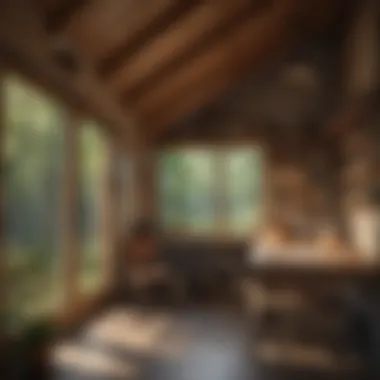

Before the first beam is laid, site preparation takes center stage. This involves evaluating what needs to happen on the ground to create a solid foundation for your prefab cabin. It’s not merely about clearing the land; it encompasses soil testing, grading, and determining drainage patterns to prevent future issues.
- Soil Testing: Understanding the soil beneath is vital. Some soils can support heavy structures, while others require additional reinforcement. Knowing the type can save lots of headaches down the road.
- Clearing and Grading: Removing any vegetation, rocks, or debris is essential. Grading ensures that the area is leveled; it helps control water drainage and avoid pooling that can weaken the cabin's foundation.
- Permits and Regulations: Getting the legal ducks in a row is a must. Local government regulations can dictate what can be built and where, making it crucial to get the proper permits before initial work starts.
Being thorough at this stage can really pay off in the long run, ensuring that your cabin has a sturdy and reliable base to stand the test of time.
Assembly Methods
With the site ready, it's time for the nitty-gritty of assembly methods. This is where the magic happens, as the prefab components come together to form your one bedroom haven. The advantages of prefab construction are paramount, making this a favored option among many.
- Panelized Construction: This method involves constructing wall panels in a factory and transporting them to the site for assembly. It’s efficient and allows for precision, ensuring that every piece fits snugly.
- Modular Construction: Similar to Legos, entire sections of the cabin are built off-site and then assembled at the location. This method can significantly reduce construction time and labor costs.
- Mobile Structures: For those opting for a more temporary solution, mobile cabins can be designed. These are built on wheels, offering flexibility in location while maintaining comfort.
Regardless of the method chosen, the focus remains on quality and structural integrity. A thoughtful assembly approach can greatly enhance the longevity and overall satisfaction of your cabin.
Inspections and Certifications
Through the entire construction process, inspections and certifications play an essential role in safeguarding your investment. These evaluations ensure that the cabin is constructed to meet local codes and industry standards, providing peace of mind for homeowners.
- Building Inspections: Local authorities often mandate inspections at various stages of the construction process. This can include checking the foundation, framing, plumbing, and electrical systems to verify everything is up to snuff.
- Energy Efficiency Certifications: With the growing emphasis on sustainability, many homeowners seek energy efficiency certifications. This attests to the cabin's ability to minimize energy consumption and carbon footprint, adding value to the property.
- Final Certification: Once everything has been inspected and passed, you will receive a final certificate of occupancy. This document is your golden ticket to move in and enjoy your new home.
"A well-constructed cabin not only protects against the elements but also provides a sanctuary where memories will be made for years to come."
By paying careful attention to each step in the construction process, you ensure not only a well-built one bedroom prefab cabin but a space that truly feels like home. Whether you're seeking a weekend getaway or a permanent residence, mastering the construction process sets the stage for success.
Energy Efficiency and Sustainability
As we delve into the concept of one bedroom prefab cabins, energy efficiency and sustainability stand out as crucial factors driving their design and construction. In today’s world, where environmental concerns are becoming more pressing, these aspects not only signify a responsible choice but also translate into long-term savings for homeowners. The integration of energy-efficient practices within the framework of a prefab cabin offers various benefits, including reduced utility bills and a minimized carbon footprint, appealing to eco-conscious individuals.
Through a combination of innovative technologies and smart design choices, prefab cabins can harness natural resources and reduce reliance on external energy sources. This commitment not only enhances the living experience but also fosters healthier ecosystems, making prefab living an attractive option for many.
Passive Solar Design
One robust strategy within energy efficiency is passive solar design. At its core, this approach leverages the sun’s energy to heat and light spaces without relying on mechanical systems. By strategically orienting windows and installing overhangs, homeowners can maximize natural light while keeping the interior cool during hot summer months. For instance, a one-bedroom prefab cabin with large south-facing windows allows sunlight to pour in during the day, warming the interiors, while carefully placed eaves provide shade when the sun is at its highest.
Using thermal mass materials, such as concrete or brick, can further stabilize indoor temperatures. These elements absorb heat during the day and release it slowly after the sun sets, ensuring comfort without the need for constant heating or cooling.
"Passive solar design not only enhances the comfort of a home but also significantly reduces energy consumption, leading to lower bills and a positive environmental impact."
Energy-Efficient Appliances
Another vital component of energy efficiency in one bedroom prefab cabins is the adoption of energy-efficient appliances. Selecting appliances that consume less energy can make a notable difference in a household's overall power requirements. Opting for Energy Star-rated refrigerators, dishwashers, and washing machines makes them not just eco-friendly choices but also pocket-friendly ones in the long run.
In a one-bedroom cabin, where space may be limited, compact yet efficient appliances like convection microwaves or induction cooktops can save both energy and valuable living space. By minimizing energy waste, these appliances empower homeowners to maintain modern conveniences while staying aligned with sustainability goals.
Water Conservation Practices
Water conservation is also a fundamental aspect of creating an energy-efficient and sustainable living environment. One-bedroom prefab cabins can incorporate several water-saving practices that benefit both the homeowner and the planet.
- Low-flow fixtures: Installing low-flow showerheads and faucets helps reduce water usage without compromising on comfort.
- Rainwater harvesting: Collecting and storing rainwater can be a game-changer for outdoor irrigation or even flushing toilets. This practice lessens dependency on municipal water sources.
- Native landscaping: Designing gardens with drought-resistant plants not only beautifies the surroundings but also significantly reduces water consumption.
In essence, embracing these practices creates a more sustainable living experience, allowing homeowners to feel good about their environmental impact.
Financing Your One Bedroom Prefab Cabin
When it comes to turning the dream of owning a one-bedroom prefab cabin into reality, financing plays a crucial role. Understanding the financial avenues available can significantly impact the feasibility and enjoyment of this choice. This segment will explore key aspects of financing, detailing loan options and government incentives tailored for individuals and families eyeing a cozy, customizable living space.
Loan Options and Mortgages
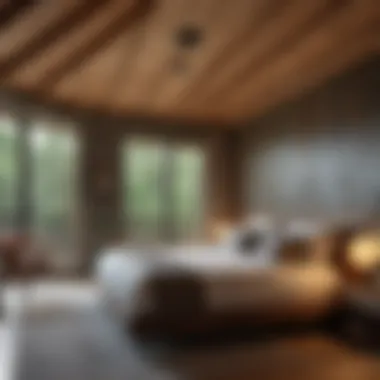

Securing a loan for your one-bedroom prefab cabin can be different from more traditional home purchases. While many might think obtaining a mortgage is only suitable for standard houses, a variety of options exist specifically for prefab homes. Here are some popular loan types you may want to consider:
- Conventional Loans: These are common home loans primarily offered by banks and credit unions. They often require a solid credit score and a substantial down payment, typically around 20%. A conventional loan might be suitable for those with a stable income ready to invest upfront.
- FHA Loans: Insured by the Federal Housing Administration, these loans are designed to make homeownership more accessible. They generally allow for lower down payments—sometimes as little as 3.5%—and are ideal for first-time buyers or those with less than perfect credit.
- Chattel Loans: If your prefab cabin is considered personal property instead of real estate, a chattel loan might be what you need. These loans cater to movable structures and can often be obtained with less stringent qualification requirements.
- Construction Loans: If you're building your one-bedroom cabin from scratch or customizing it substantially, a construction loan may be the right path. These loans are typically short-term and cover the cost of construction, converting to a mortgage once the cabin is completed.
Choosing the right loan depends on various factors, including your financial situation, where you plan to place your cabin, and whether it's existing or a new construction. Always read the fine print and work with a financial advisor if necessary.
Government Incentives
When considering funding your one-bedroom prefab cabin, it’s advantageous to explore potential government incentives. These programs are designed to encourage sustainable and affordable housing, providing financial relief and support for homeowners:
- Tax Credits: Many states and local governments offer tax incentives for energy-efficient homes. If your prefab cabin incorporates eco-friendly designs or materials, you may qualify for significant tax credits.
- Grants: Some programs offer direct grants to individuals looking to build or renovate affordable homes. These funds do not require repayment, making them an appealing option if you are eligible.
- Energy Efficiency Rebates: Various utility companies provide rebates for energy-efficient appliances and installations in homes. This could help offset some of the costs associated with equipping your cabin with sustainable features.
Government incentives can significantly ease the financial burden of building a prefab home. Each area has its own set of rules and benefits, so it’s wise to do thorough research to know what applies to you.
Lifestyle Considerations
In considering a one bedroom prefab cabin, it’s essential to delve deeper into how these structures can align with various lifestyles. This exploration involves understanding what it means to live in such a space. A prefab cabin can represent much more than just a dwelling; it can also foster independence, sustainability, and a closeness to nature.
Living Off-Grid
Living off-grid has grown in popularity among those looking to escape the hustle and bustle of modern life. Prefab cabins often provide an ideal solution, offering comfort while minimizing one's ecological footprint. Imagine relying on solar energy for power, collecting rainwater for household use, and growing a small garden right outside your door. This kind of self-reliance can introduce a sense of peace and fulfillment.
Think about the practicalities:
- Simple Maintenance: Prefab units are generally designed for easy upkeep. Since they are often constructed using modern materials, they can withstand environmental stress while requiring minimal attention.
- Energy Solutions: Many models today come equipped with energy-efficient systems. Solar panels can be integrated easily, enabling off-grid living without the usual headaches associated with energy management.
- Integration with Nature: Prefab cabins are often nestled in beautiful surroundings, creating an organic connection to the outdoors. This can even boost mental well-being, with studies showing time in nature has positive effects on mood and focus.
Investment Potential
Prefab cabins present a unique avenue for investment. With the real estate market continually evolving, embracing this trend can yield rewarding dividends. Acquiring a one bedroom prefab unit can be a smart strategy for property investment, as interest in tiny living spaces is surging.
Here are some points to consider:
- Affordability: The initial cost of a prefab cabin is often lower compared to traditional homes, making them accessible to first-time buyers and seasoned investors alike.
- Resale Value: As more people seek sustainable living options, the appeal of prefab cabins continues to rise. Properties that blend modern amenities with eco-friendly features are becoming hot commodities.
- Rental Opportunities: With the growing trend of vacation rentals, a one bedroom prefab cabin can serve as an attractive rental property. Short-term stays in unique accommodations are highly sought after, bringing in additional income.
Community Living
Community living often represents a chance for shared experiences, resources, and values. Prefab cabins support this lifestyle well, especially when part of larger communities focused on sustainability or alternative living. Residents often share amenities and help one another, creating a strong support network.
- Shared Spaces: Many prefab communities incorporate shared gardens, gathering spaces, or workshops. This encourages social interaction and collaboration, fostering a sense of belonging among neighbors.
- Collective Innovation: Living in a community can lead to shared ideas for sustainability, whether it’s a group initiative to reduce waste or collective purchasing of bulk supplies.
- Support System: Especially for families or those entering retirement, having a community can provide a vital support system for emotional and practical needs. This can make a huge difference in the quality of life for residents.
By examining these three aspects of lifestyle considerations—living off-grid, investment potential, and community living—one can see how a one bedroom prefab cabin can fit seamlessly into a diverse array of life choices. The nuances within this lifestyle offer compelling benefits that align closely with modern values of sustainability, practicality, and connection.
The Future of One Bedroom Prefab Cabins
The future of one bedroom prefab cabins holds immense significance in the overall landscape of contemporary housing. As environmental concerns grow and urban spaces become crowded, these cabins offer a versatile solution that merges efficiency with sustainability. Homeowners today are seeking more than just a roof over their heads; they desire spaces that resonate with their values and lifestyles. The adaptability of prefab cabins reflects an optimistic and pragmatic shift towards housing that not only meets personal needs but also contemplates broader ecological impacts.
Emerging Trends
Emerging trends in the prefab cabin market are a response to changing lifestyles and expectations. One such trend is the rise of multifunctional spaces. You might notice that more designs incorporate flexible areas, allowing homeowners to use a single room for various purposes. For instance, a living area that doubles as a workspace or a guest room can maximize limited square footage, making daily life simpler without feeling cluttered.
Another trend worth noting is the shift towards integrating smart technology into prefab designs. Nowadays, homeowners are not just interested in aesthetics but also want functional innovation. Features like programmable thermostats, security systems, and energy management apps have become increasingly desirable. This technology enhances living experiences and makes managing energy consumption a breeze, leading to a more sustainable home environment.
Furthermore, the appeal of local materials is climbing. As people become more conscious of their carbon footprints, many cabin manufacturers are sourcing materials from local suppliers. This approach not only supports regional economies but also ensures that the materials blend seamlessly with the surrounding environment. For homeowners, this translates to homes that are visually appealing and environmentally responsible, adding to the charm of their living spaces.
Technological Innovations
Technological innovations pave the way for prefab cabins to achieve new heights in design and functionality. 3D printing is one remarkable advancement that has begun infiltrating the prefab sector. It allows for precise customizations at a fraction of traditional costs, making unique and eye-catching designs accessible for the average homeowner. Imagine being able to personalize your cabin down to the very last detail—now that's a game changer.
Moreover, construction techniques are evolving too. Modular systems are another noteworthy innovation, permitting builders to assemble cabins off-site in controlled environments and subsequently transport them to their final locations. This minimizes construction time significantly while also reducing waste, a huge plus when looking to maintain sustainability.
Finally, advancements in insulation technology and energy systems are making these small homes more energy-efficient. Innovations like advanced foam insulation and solar panel systems integrated from the get-go help keep utility bills low and energy use minimal.
The combination of smart design, local materials, and cutting-edge technology secures the place of one bedroom prefab cabins as a forward-thinking alternative in modern housing.
As we move forward, it’s clear that one bedroom prefab cabins will not only survive but thrive, adapting to the evolving needs and aspirations of homeowners everywhere. By understanding these emerging trends and technological innovations, potential buyers can make informed decisions, ensuring that their cabin is not just a home, but a lasting investment in sustainable living.






